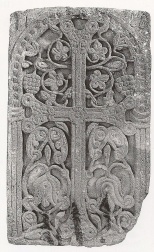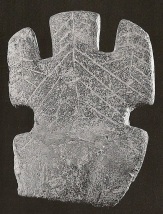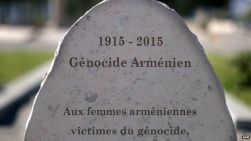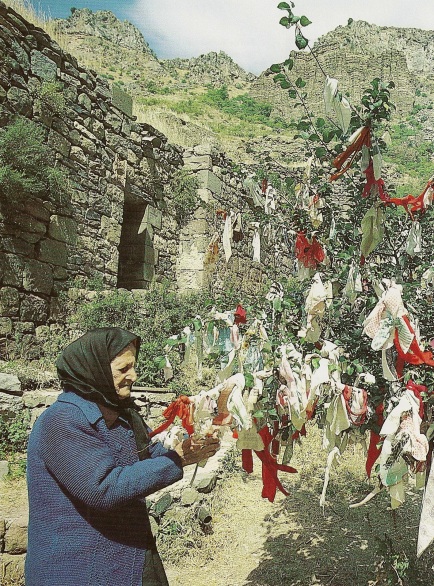
Friday, April 24, 2015 marks one hundred years since the start of the Armenian Genocide of 1915.
In my dance workshop last Sunday in Somerset, England, we lit candles to the exquisite voice of the great Armenian soprano Lusine Zakarian, and danced beautiful Armenian dances in a ritual of solidarity with this occasion.
I have been encouraging all my students to dance Armenian dances with their groups this week, most especially on Friday, to align with the commemorations happening around the world. Even if you do not dance, you could simply light a candle and listen to some Armenian music (see my list of recommendations at the end of this post). I feel that every act of compassionate witnessing, however small, helps heal the wounds of history.

- Khachkar from Zangezur, 10th C.
Why Armenian dances? I am not Armenian, yet in my thirty years of researching and teaching traditional dances, Armenian dances have held a particular fascination for me, in their poignant melodies and timeless gestures expressing love, longing and homecoming.
Armenian Christianity has also been a tremendous source of inspiration. The Armenian khachkar (‘stone cross’) is magnificently life-affirming, in that the cross, rather than an instrument of suffering, is the Tree of Life, revealing the living wisdom of Christ’s teachings. Since antiquity, the Tree of Life has also represented the Goddess, originally worshipped in Armenia as Anahit, Saris, Nar, and Nune.

- Armenian Goddess figure with upraised arms and incised leaf/tree design (Teshebaini, 1st millennium BCE)
Armenia was the first nation to adopt Christianity, in 301 CE. Perhaps because it developed so early, the Armenian Orthodox church retains features of its nature-reverent origins. A solar symbol appears on every khachkar, embedded in the roots of the Tree to show union and balance, rather than separation, between earth and sky, spirit and matter. These are also the key principles of Armenian traditional dance, which I have been exploring in movement for thirty years.
In 2001 I travelled to Yerevan with my friend and colleague Shakeh Tchilingirian to research traditional women’s dances overlooked by other dance ethnographers. With the CD and booklet we produced there, we were able to bring to our students archaic ritual dances to invoke fertility, end drought, or ask the blessings of the Virgin Mary.
During our time in Armenia, I was deeply touched by the extraordinary hospitality and what I see as the inherent grace and dignity of the Armenian people. Conscious of what they have lost, the Armenians I’ve had the good fortune to meet all over the world are keeping their culture alive through their language, music, dance, faith, family and community.

- French memorial stone to the Armenian women who died
The Armenian Genocide of 1915-1923 is considered the first genocide of the 20th century. One and a half million Armenian subjects of the Ottoman Empire were killed, through massacres and forced marches into the deserts of Anatolia (and, yes, Syria). As a result, millions more Armenians now live in the worldwide Diaspora than in the tiny present-day Republic of Armenia.
Turkey today refuses to acknowledge that it was genocide, an act of denial which infinitely compounds Armenians’ pain. The overwhelming majority of historians, academics and institutions of Holocaust and Genocide Studies do, however, recognize the Armenian Genocide, along with dozens of countries including Russia, France, Germany, and forty-three US states. Because I also love Turkey and Turkish dances, I spent years thoroughly researching in order to decide for myself, and I also conclude that it was genocide; the deaths of hundreds of thousands of innocent women, children and elders did not happen ‘in combat’.

Anniversaries of this nature bring up the pain of the original event, as well as the additional pain of seeing the same cruelty continue unchecked in our time, when we had hoped we would have learned by now. But these commemorations are also an opportunity to bring our pain into the presence of that which comforts, witnesses and heals, and here is where dance and music can help us when words sometimes fail.
My friend Shakeh Tchilingirian led an event recently at the School of Oriental and African Studies in London, inviting Armenians, Turks, Kurds and Assyrians to dance together for reconciliation, in commemoration of the Armenian Genocide and other atrocities around the world (a touching new film, Circle of Life, documents this event). As part of the ceremony, Shakeh prepared 50 paper butterflies, each representing a distinct ethnic group targeted by genocide within the last century. Fifty groups in 100 years – and that isn’t even all of them!
What do we do when faced with historical atrocities on such a scale?

- A finely embroidered Armenian silk and cotton towel end from the late 19th C., before the genocide. Author’s collection.
George Santayana famously warned that ‘those who cannot remember the past are condemned to repeat it’, and yet, as this history of annihilation repeats itself again and again in our time we seem to have become, in the words of Pakistani novelist Kamila Shamsie, ‘amnesiacs without curiosity.’
But it doesn’t have to be this way. All it takes to wake up and recover both memory and curiosity is for each of us to choose: to think more carefully, to inform ourselves more fully, and to ask how we can be of practical help in this situation. Then we simply take the first step. Practical action is extraordinarily empowering, whether we sign petitions, speak truthfully in public, or join hands together and dance.
You don’t have to be Armenian. In fact, only when we who are not directly affected by a tragedy rouse ourselves to care about it, can we truly shift the dynamic of oppression in our world and reclaim the power to create a society of justice and peace.
So please join us this week, in spirit, in dance, in prayer and in whatever way you can, to send compassion, support and strength to the worldwide Armenian community, and to all ethnic groups and dispossessed peoples who have faced the devastation of exile and genocide. Together we can affirm the survival of all that is most valuable in the human family, and thus make conscious choices for a better future.
See these additional resources to learn more:
Website: The Armenian Genocide Centennial site has links to stories and information on many worldwide events taking place this month.
Film on Youtube: Shakeh Tchilingirian’s Circle of Life in Commemoration of the Armenian Genocide and Atrocities around the World.
The Guardian article: Barack Obama will not label 1915 massacre of Armenians a genocide.
BBC News article: Armenian tragedy still raw in Turkey 100 years on, by Mark Lowen (22 April 2015, Istanbul) and The Armenian Rugs that Tell Two Stories
NPR Stories: Friday Marks Centennial Of Armenian Mass Killings During World War I and Turks And Armenians Prepare For Dueling Anniversaries On Friday
Museum: Armenian Library and Museum of America in Watertown, Mass.
Dance: Armenian Lyrical Dances with Laura Shannon this summer at the Findhorn Sacred Dance Festival July 25-31, 2015.
Books:
The Crossing Place: Journey Among the Armenians, by Philip Marsden
The Forty Days of Musa Dagh, by Franz Werfel
Armenian Folk Arts, Culture, and Identity, by Levon Abrahamian, Nancy Sweezy, Sam Sweezy
Music:
Gorani: Traditional Dances from the Armenian Homeland
Shoghaken Ensemble: Traditional Dances of Armenia
Djivan Gasparyan: I Will Not Be Sad in This World; Moon Shines at Night, Apricots From Eden, etc.
Norayr Kartashyan: Tsarastan
Khatchatour Avetisyan: Oratorio in Memory of the Victims of the Armenian Genocide of 1915
Lusine Zakarian
Haig Yazdjian
Night Ark
Kardes Türküler
Erkan Ogur and Djivan Gasparyan: Fuad
Laura Shannon has been researching and teaching traditional women’s ritual dances since 1987. She is considered one of the ‘grandmothers’ of the worldwide Sacred / Circle Dance movement and gives workshops regularly in over twenty countries worldwide. Laura holds an honours degree in Intercultural Studies (1986) and a diploma in Dance Movement Therapy (1990). She has also dedicated much time to primary research in Balkan and Greek villages, learning songs, dances, rituals and textile patterns which have been passed down for many generations, and which embody an age-old worldview of sustainability, community, and reverence for the earth. Laura’s essay ‘Women’s Ritual Dances: An Ancient Source of Healing in Our Times’, was published in Dancing on the Earth. Laura lives partly in Greece and partly in the Findhorn ecological community in Scotland.


Fethiye Cetin has written a wonderful memoir of her gandmother called My Grandmother. She was an Armenian girl captured by a Turkish General and she did not tell her family about this for many years until she told her grandaughter Fethiye who is the lawyer for Hrant Dink’s family (Hrant, a journalist who was murdered in 2007).
The book is available in Australia and New Zealand from Spinifex ( the publishing house I co-founded); in UK from Verso; originated in Turkey by Metis Publishing. Sorry I don’t know the US publisher. Fethiye’s surname has a cedilla beneath the C.
LikeLike
Thanks for this Laura.
As you probably know we have a cloth tree in Lesbos, I wonder if it is a local tradition, was brought by Armenians during the Ottoman Empire, or was brought after 1922 by Greek refugees who had encounterd the tradition in Turkey. Turkish Muslim women leave scarves at a shrine of a saint church somewhere along the old road between Avalik and Pergamon. In ancient Greek times brides left articles of their unmarried clothing on a tree (I believe it was) to Artemis. No matter the origins, the practice has come into different religions and strands of traditions.
LikeLike
Yes, I have seen the wishing trees elsewhere in Greece, and have heard that it is a Celtic tradition in ancient Britain (they call them ‘clootie wells’, apparently, and tie the cloths or ‘clooties’ to a tree near a sacred spring). Just now I heard from my dear friend Shakeh, in Istanbul today for the commemorations. She writes the following:
“We attended a very emotional Church service this morning and are preparing to go to Taksim Square where we will tie pieces of Hovig’s Muslin to a wishing tree (project by a Turkish artist) and then participate in a vigil at 19:15.’
Hovig is Shakeh’s young son. They went as a family (from London) to be part of the ceremonies. I am certain he will never forget it. How amazing that a Turkish artist had the idea to incorporate the tradition of the wishing tree into today’s events.
LikeLike
Laura:
I AM Armenian. The Armenian flag on the flagpole in front of our house is at half staff today as part of my personal commemoration of the 100th anniversary of the genocide. My grandfather and father almost… almost… went back to “the old country” for a visit at just this time, 100 years ago. If they had, I might not be writing this: among other places, they were going to visit relatives in Adana.
Like you, I have always found Armenian music, dance, and art a wonderful way to connect with my ancestors and history, so I found your piece here a lovely and unexpected gift this morning. You may not be Armenian by blood, but you certainly are one of the heart.
Thank you, too, for calling the genocide –one of only too many– by its proper name. Until the Turkish government is able to do just that, no real healing between otherwise well-intentioned people on both sides can truly take place.
Having said that, I need to tell a story from my family’s oral history.
A great aunt and uncle, as children, had been sent on some errands in Bitlis (now in Turkey) by their mother. Suddenly a Turkish woman appeared from her house hissing beneath her breath “Ssst! Little Armenian children! You must come with me! Now!” The woman grabbed them by their arms and pulled them inside. They were terrified.
She hid them for three days, as Turkish soldiers searched the town for Armenians, killing some. When it was safe, she sent them home, with food. Because of this unknown Turkish woman, my relatives survived one rehearsal for genocide.
Your work, not only with Armenian culture, but with all the others you research, experience, and communicate so well, is a little like the Turkish woman: one person’s contribution in good will can be a reminder to all of us that we can, as you say so well, “affirm the survival of all that is most valuable in the human family” and so make better choices for the future.
La vem: thank you.
LikeLike
Thank you both for these remembrances and for witnessing to the healing potential of honest remembering and naming.
LikeLike
Onoosh, thank you so much for sharing your family’s amazing stories of survival. Picturing your great aunt and uncle as children being saved by the unknown Turkish woman, I like to think that there were many such, in every genocide, who did what they could to save lives, at no small risk to themselves. At least I hope so. Thank you.
LikeLike
Thank you for this article and for sharing it with the circle dance network in the UK. Inspired by your first message earlier this week and because of the repertoire of one of the founding members of our circle, we were able to spontaneously dance Garoun together last Tuesday evening at the monthly gathering of our circle in Western Canada. I am grateful for what we have learned from you.
LikeLike
I am so glad to hear it! Even a little candle can carry the fire a great distance – and remember, were you there years ago in Edmonton when we danced the Armenian dance Mom Govand – ‘candle dance’ – where our own upright hands waved gracefully to represent the light? Even without candles, we can keep the flame alive!
LikeLike
Thanks for this post. I’ve had several Armenian friends. I edited a book for one of them and we became friends (we were both Unitarian at the time) and I was invited to some family holidays. I don’t remember if the family discussed the genocide, but my friend and I did once or twice. It was because of the genocide that her family lived in Southern California, and they had a long, dangerous journey to get here.
LikeLike
As did so many, of all nations. And since the theme of unacknowledged genocide is so much a part of these centennial commemorations, I can’t help but think of the Native Americans whose extermination ‘made way’ for the new immigrants to settle. Truly, so many stories interwoven, and so many broken threads. How can we ever make a whole fabric in the human family?
LikeLike
Thank you for this post Laura.
LikeLike
Thank you Laura for being the person you are, for your courage, your insight and determination to pursue what you believe to be the way forward in your heart- yesterday as we attended the packed Mother Cathedral in Istanbul for the remembrance service “for the victims of 1915” (as a Diaspora armenian) I was struck by the strength of faith and commitment of my surrounding Tiurkish Armenians- I felt “showered” with love and protection as they sang so beautifully and recited every single word of the Creed in UNISON “in one breathe as one body”- I could not hold back my tears for the best part of the service. It struck me time and time again that they are the direct survivors of the Genocide and they are still singing and praying and NOT embittered- their commitment to the land they inhabit is SO strong despite (what I have witnessed and heard over these past few days) the intermittent poisonous /derogatory comments and behaviour towards them by SOME individuals and institutions… There is a lesson to be learned here. We are all victims of the situation we find ourselves in and the longer these wounds bleed the more difficult it becomes to heal. Last night I read some of the messages on The Wishing Tree (messages remembering ALL victims of atrocities and genocide as well as the displaced- I read). There were thousands possibly tens of thousands of people (I am not sure) sitting silently in Taksim Square- many Turks and Kurds amongst us- the Turkish Armenian lady sitting next to me told me “there are more Turks than Turkish Armenians here”. I sat opposite Hrant Dink’s widow and Fettiyeh Cetin amongst others. There were so many diasporan intellectuals, activists, actors… As they say you can bury bodies but you can’t bury the truth.
LikeLike
In response to Laura’s article, I dedicated a monthly gathering I facilitate (honoring the divine feminine with dance, prayers and a Sophia celebration) in remembrance of the Armenian Genocide experience in 1915 and by extension, the genocide experiences of people throughout the history of the world.
We addressed prayers to Our Lady of Sorrows and the Mother of Consolation, who has known the pain and suffering of the killing fields of humanity for thousands of years. Then we danced one of the most ancient Armenian “Tree of Life” dances, a stately and dignified ceremonial dance called Mairam Govand. (Mairam is the name Mary). We finished with Meryem Ana, a Turkish dance honoring “Mother Mary”, pictured as a river of life. In this dance we trace out a zigzag pattern on the earth, representing, since ancient times, water, life, lightning, spirit, light. (Both dances learned from Laura Shannon.)
In our remembrance of genocidal atrocities it was a healing consolation to be able to dance patterns on the Earth, Herself, reaffirming through our living, breathing movement, the Tree of Life. We were also grateful to elders and teachers who have passed on the possibility of healing through honoring the divine feminine and through ritual and dance.
In these comments Laura refers to unacknowledged genocide and the Native American experience. Denial and lack of acknowledgement serves to prolong the pain of trauma, re-traumatizing people already carrying the load of the effects of generational trauma, effects now confirmed by research.
It is interesting that in a brief Internet search on “genocide” I found only two references mentioning the Native American experience. In both cases it was either denied or minimized by focusing on the fact that more Indians died of European diseases, and by using terms such as “discrimination” and “racism” to describe the genocide experience (which took place over hundreds of years).
There is plenty of documentation of the genocidal intent, policies, and destruction of Native Americans which fits every aspect of the UN definition of genocide.
The following are a few examples from only one well documented and referenced source, Daughters of Mother Earth, the Wisdom of Native American Women, (ed. by Barbara Alice Mann, forward by Winona LaDuke):
“Anyone who thinks that the slaughter of innocents— at what is known as “The Great Swamp Fight” (1675) in what is now Rhode Island, Goschochking (1782) in what is now Ohio, Sand Creek (1864) in what is now Colorado, or Wounded Knee (1892) in modern-day South Dakota— was horrifying should study the conquest of California during and just after the Gold Rush for tales of true terrorism, worse even than the Long Walk of the Diné or the Cherokee Trail of Tears… the California murders were proudly published in the local papers. The Sacramento Bee of the mid-nineteenth century is a major source of back-slapping tales of slaughter. (p.7)
The Iroquois called the American Revolution Hanötaká:nyas or “Holocaust”, which literally translates as “He Consumes It by Fire” or “He burns it”, the “He” referring to the American Army, acting under the orders of George Washington, who was himself frequently referred to as “The Town Burner.” In 1926 Arthur Parker, a Seneca and scholar, rendered the Iroquois word as “Holocaust.” (pp. 69, 100)
And in 1905 the commissioner of the Bureau of Indian Affairs, Francis E. Leupp, referred in a government report to his plan in dealing with the Indians, as “the final solution”. (p. 90)
Unfortunately there is nothing new or original about modern genocide, aside from the application of modern bureaucratic methods and technology. A review of ancient history and the Old Testament of the Bible is enough to convince one that this impulse to rid ourselves of the “Other” goes way back and has manifested on every inhabited continent in the world.
Yet the opposite impulse also exists. Again, one example (from the aforementioned book): “Traditional culture sought to include as many people as possible. The whole point of Native adoption, one of the most ancient and widespread of Native American laws, was precisely to undercut the impulse to hostile exclusion by making the Other, the Self. The minute we “eat from one bowl” using “one spoon” as the Northeastern metaphor goes, we are relatives, forbidden to make war upon one another.” (“Eating from one bowl, using the same spoon is the traditional metaphor in the East for recognizing one another as relatives.”) (pp. 88, 105)
In our Sophia celebration we share milk from one cup and honey from one bowl, and in so doing we are not only participating in the Lady of All Peoples’ “peace bestowing mission,” but also the Native American practice of recognizing each other as relatives, summarized in the words of the Lakota blessing invoking the oneness or interconnectedness of all creation, Mitakuye Oyasin, “we are all related” (also translated “all my relatives” or “all my relations”).
Molly Rose
LikeLike
Thank you for caring.
Genocide is a crime against all humanity and it does pull us from our hummane roots and denying it every year ,it does kill the hummanity within .
Only healing will pain of the Genocide will re-ignite hummanity in all .
LikeLike